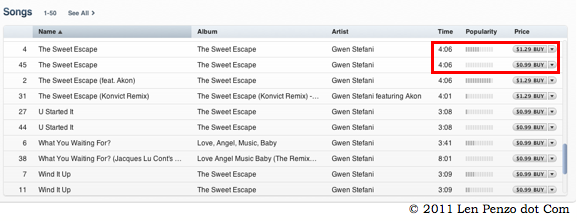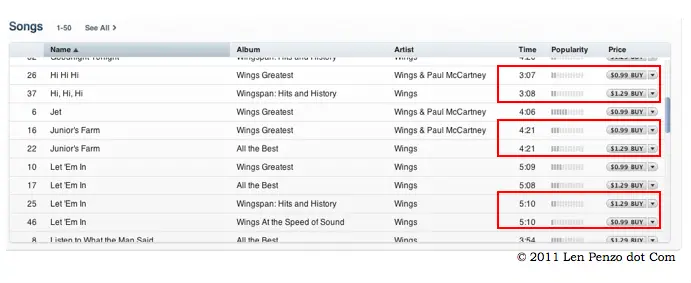 I’ve written before about my insatiable addiction to iTunes; it’s one of the biggest money leaks I have to deal with on a monthly basis.
I’ve written before about my insatiable addiction to iTunes; it’s one of the biggest money leaks I have to deal with on a monthly basis.
Believe it or not, some months I’ll spend upwards of $100 on iTunes songs for my iPod, although I’m trying my level best to rein in that nasty little habit. In the meantime, I do my best to find iTunes bargains wherever I can. Let’s face it, the cost and convenience of iTunes simply can’t be beat.
In fact, I hope you don’t think I’m being too crotchety when I say kids today don’t realize how good they have it. It’s true. Gone are the days when people had to run down to the local record store and pluck down $11.99 for a CD just to get one good song on an otherwise stinky album.
Now, for prices ranging between $0.69 and $1.29, you can buy songs a la carte using a laptop computer while sitting on your living room couch in your underwear. That’s not to say that’s what I do, but you get my drift. (Oh alright, maybe I’ve done that once. Maybe.)
Do You Overpay for Your iTunes?
Here’s a friendly tip for you: savvy iTunes shoppers know that the iTunes Store often sells the exact same songs for different prices. To prove it, I did a little shopping yesterday and took some screen shots to show you exactly what I mean.
For example, I found iTunes offering Gwen Stefani’s single “The Sweet Escape” for both $1.29 and $0.99. It’s interesting to note that the only difference between the two songs is that the 99-cent version is pulled from the “clean version” album that doesn’t come with a parental advisory. However, the two singles are identical.

By failing to look at all of the songs available in the iTunes catalog, the majority of Gwen Stefani fans ended up paying 30 extra cents for The Sweet Escape single. (Screen shot taken on March 27th, 2011.)
Even so, the majority of Stefani’s fans bought the more expensive version of “The Sweet Escape.” Believe it or not, so many people inadvertently paid the extra 30 cents that they’ve made it the fourth most popular song in her catalog. Meanwhile, the exact same tune offered for 99-cents languishes at number 45 — very near the bottom in terms of the most-popular Stefani iTunes purchases.
In another example of iTunes offering the same songs for different prices, look at the next screen shot from the catalog of Paul McCartney’s “other” band Wings. (For those of you under 35 that have no idea who I’m talking about, you can look him up on Wikipedia.)
In this shot, you can see not one, but three different songs — “Hi, Hi, Hi,” “Junior’s Farm,” and “Let ‘Em In” — offered at both $1.29 and $0.99. Again, even though they are priced differently, the songs are the identical original studio recordings that are simply pulled from different albums. At least in this case, it appears that none of the three songs were purchased by the majority of iTunes shoppers at the higher price.

Another example of iTunes charging the same price for the same song. When shopping on iTunes, sorting by song title — rather than by the default popularity — allows you to see if you are buying a song at the cheapest available price. (Screen shot taken March 27, 2011.)
More Money-Saving iTunes Tips
1. Sort by song title — not popularity. When shopping on iTunes, artist song catalogs are normally sorted from the most popular song to the least popular. The problem is that method of sorting often results in a lot of people overlooking the same song at a cheaper price further down the list. Instead, make sure you sort the catalog by song title — that way all the songs are grouped together so you can easily compare prices. To do so, simply click on the bar above the songs where it says “Name.”
2. Be sure to preview the songs before buying! Those 69-cent and 99-cent sings aren’t always identical to the $1.29 versions. In the case of newer music, the cheaper versions may have edited, cleaner lyrics. Meanwhile, with older songs, you need to be on the lookout for re-recordings made by the original artists. More often than not they sound noticeably different from the song you remember hearing on the radio.
3. Always back-up your purchases. Let me repeat that. Back. Up. Your. Purchases. If your computer ever crashes, you are at risk of losing all your iTunes purchases — and in my case that would result in a significant financial loss. Thankfully, iTunes gives you the option to save your iTunes Store purchases to a blank CD for safekeeping. In the event of disaster, those discs will be the lifeline that allows you to automatically restore your iTunes library; iTunes makes the whole process so convenient there really is no excuse not to do it.
Speaking of convenience, I hate to admit this but, the other day while I was sitting at my computer I noticed that Maroon 5’s single “Misery” was missing from my iPod, so I bought it off iTunes — even though I had their CD that featured that single in my CD player downstairs.
That’s right. I was willing to pay $1.29 for a song I already owned because I was too lazy too get off my butt, march downstairs to grab the CD, and then take 10 seconds to transfer the tune to my iPod. Yes, I’m pitiful.
You know, on second thought, perhaps iTunes can be just a bit too convenient at times.
Photo Credit: angelandspot

You are a very good writer, and I appreciate your info. I stumbled across your data because I wanted an answer, why iTunes price the same album at different cost, ie. Suzanne Teng’s album Enchanted Wind sells for $9.99 and also 7.99? Would your principle apply in this case?
Yes, Milton, the same principle applies — just sort by “album” instead of “song.”
I do not know the logic behind iTunes pricing. Frankly, I don’t think they have a strategy.
Do you happen to know when or how often iTunes does the .69 songs? It’s just hit or miss, or so it seems.
Laurie, it is hit or miss. It seems like it is getting harder and harder to find the $0.69 tunes now though.
I just did a quick survey of the Top 30 Pop songs on iTunes. Here was the breakdown:
$0.69: 2 songs
$0.99: 3 songs
$1.29: 25 songs
How does a computer lose itunes purchases?
Is that a rhetorical question, Steven?
I just have never heard of a computer losing itunes purchases from a computer crash before
It happens.
I thought itunes remembers your purchases from your account history